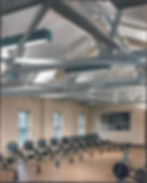Photography by:
Ralph E. Dinneen
Brown University, Marsten Boat House
Location
20 India Street
Providence, RI
By the numbers
Institutional, All Projects
3 Floors
18,800 SF
Completed Fall 1994
Collaborators
Brown University Department of Planning - Owner/ Landlord
E&M Engineering, Inc. - MEP Consultant
R.W. Thayer, ASLA - Landscape
VIVO - Building Code
Featured In
The Boathouse structure, originally a seafood packing plant, was purchased by the University in 1966. Remodeled for the crew program to accommodate shell storage, a boat shop, and the men’s team accommodations and changing facilities. A rowing tank with 16 stations was added on the first floor in 1969/1970, and subsequent alterations were made to provide minimal locker and exercise rooms for the women’s crew team, which was established in 1974.
Brown University’s goals in undertaking the project were to provide equal facilities for the men’s and women’s crew teams, upgrade and enlarge the existing exercise facilities, remedy various life-safety and ADA code deficiencies and unify the existing building forms into a cohesive design statement.
The program included: new gendered and ADA compliant lockers, showers and toilet rooms, reconfiguring the upper floors to provide workout rooms and coaches’ offices for the teams, and building a second story addition over the existing boat storage bay to house ergometer rooms. The flat roof of the third floor was replaced with a pitched roof to provide added ceiling height for the women’s exercise area and to help unify the building forms.
Special design features included: a new stair tower, which also houses a platform lift providing handicapped access to the second story, a large second story deck off the addition, a new second story balcony off the men’s coaches’ office, a full height folding partition separating the men’s and women’s ergometer rooms and a connecting corridor from the addition to the existing second story.
Structural design for the addition was particularly challenging. Subsoil investigation revealed that the existing foundations were bearing on soils and fill which were incapable of accommodating any additional load. It was therefore determined that Franki piles would be the most effective means of supporting any new structures. The second story addition is constructed of pre-engineered trusses resting on columns which pass through the existing building roof and rest on piles drilled through the existing floor slab. The stair tower is also supported on piles. Further, design had to meet structural requirements for buildings in high velocity flood zones.
Total project time, from the beginning of design to the end of construction, was just under 12 months.

Brown University, Marsten Boat House
18,800 SF
3 Floors
Collaborators
20 India Street
Providence, RI
Completed Fall 1994
Brown University Department of Planning - Owner/ Landlord
E&M Engineering, Inc. - MEP Consultant
R.W. Thayer, ASLA - Landscape
VIVO - Building Code

The Boathouse structure, originally a seafood packing plant, was purchased by the University in 1966. Remodeled for the crew program to accommodate shell storage, a boat shop, and the men’s team accommodations and changing facilities. A rowing tank with 16 stations was added on the first floor in 1969/1970, and subsequent alterations were made to provide minimal locker and exercise rooms for the women’s crew team, which was established in 1974.
Brown University’s goals in undertaking the project were to provide equal facilities for the men’s and women’s crew teams, upgrade and enlarge the existing exercise facilities, remedy various life-safety and ADA code deficiencies and unify the existing building forms into a cohesive design statement.
The program included: new gendered and ADA compliant lockers, showers and toilet rooms, reconfiguring the upper floors to provide workout rooms and coaches’ offices for the teams, and building a second story addition over the existing boat storage bay to house ergometer rooms. The flat roof of the third floor was replaced with a pitched roof to provide added ceiling height for the women’s exercise area and to help unify the building forms.
Special design features included: a new stair tower, which also houses a platform lift providing handicapped access to the second story, a large second story deck off the addition, a new second story balcony off the men’s coaches’ office, a full height folding partition separating the men’s and women’s ergometer rooms and a connecting corridor from the addition to the existing second story.
Structural design for the addition was particularly challenging. Subsoil investigation revealed that the existing foundations were bearing on soils and fill which were incapable of accommodating any additional load. It was therefore determined that Franki piles would be the most effective means of supporting any new structures. The second story addition is constructed of pre-engineered trusses resting on columns which pass through the existing building roof and rest on piles drilled through the existing floor slab. The stair tower is also supported on piles. Further, design had to meet structural requirements for buildings in high velocity flood zones.
Total project time, from the beginning of design to the end of construction, was just under 12 months.

The Boathouse structure, originally a seafood packing plant, was purchased by the University in 1966. Remodeled for the crew program to accommodate shell storage, a boat shop, and the men’s team accommodations and changing facilities. A rowing tank with 16 stations was added on the first floor in 1969/1970, and subsequent alterations were made to provide minimal locker and exercise rooms for the women’s crew team, which was established in 1974.
Brown University’s goals in undertaking the project were to provide equal facilities for the men’s and women’s crew teams, upgrade and enlarge the existing exercise facilities, remedy various life-safety and ADA code deficiencies and unify the existing building forms into a cohesive design statement.
The program included: new gendered and ADA compliant lockers, showers and toilet rooms, reconfiguring the upper floors to provide workout rooms and coaches’ offices for the teams, and building a second story addition over the existing boat storage bay to house ergometer rooms. The flat roof of the third floor was replaced with a pitched roof to provide added ceiling height for the women’s exercise area and to help unify the building forms.
Special design features included: a new stair tower, which also houses a platform lift providing handicapped access to the second story, a large second story deck off the addition, a new second story balcony off the men’s coaches’ office, a full height folding partition separating the men’s and women’s ergometer rooms and a connecting corridor from the addition to the existing second story.
Structural design for the addition was particularly challenging. Subsoil investigation revealed that the existing foundations were bearing on soils and fill which were incapable of accommodating any additional load. It was therefore determined that Franki piles would be the most effective means of supporting any new structures. The second story addition is constructed of pre-engineered trusses resting on columns which pass through the existing building roof and rest on piles drilled through the existing floor slab. The stair tower is also supported on piles. Further, design had to meet structural requirements for buildings in high velocity flood zones.
Total project time, from the beginning of design to the end of construction, was just under 12 months.











